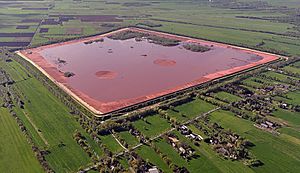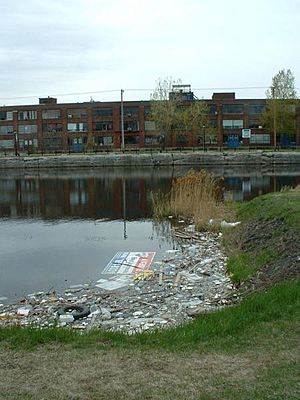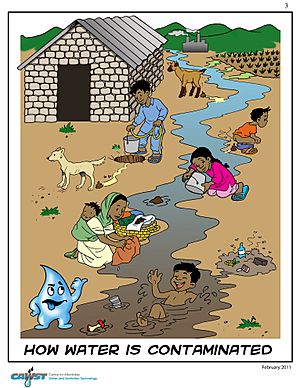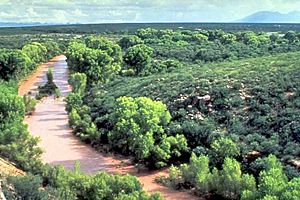Water pollution facts for kids
Water pollution (or aquatic pollution) is the contamination of water bodies, usually as a result of human activities, so that it negatively affects its uses. Water bodies include lakes, rivers, oceans, aquifers, reservoirs and groundwater. Contaminants can come from one of four main sources: sewage discharges, industrial activities, agricultural activities, and urban runoff including stormwater.
Water pollution is either surface water pollution or groundwater pollution. This form of pollution can lead to many problems, such as the degradation of aquatic ecosystems or spreading water-borne diseases when people use polluted water for drinking or irrigation. Another problem is that water pollution reduces the ecosystem services (such as providing drinking water) that the water resource would otherwise provide.
Control of water pollution requires appropriate infrastructure and management plans as well as legislation. Technology solutions can include improving sanitation, sewage treatment, industrial wastewater treatment, agricultural wastewater treatment, erosion control, sediment control and control of urban runoff (including stormwater management).
Definition
A practical definition of water pollution is: "Water pollution is the addition of substances or energy forms that directly or indirectly alter the nature of the water body in such a manner that negatively affects its legitimate uses". Water is typically referred to as polluted when it is impaired by anthropogenic contaminants. Due to these contaminants, it either no longer supports a certain human use, such as drinking water, or undergoes a marked shift in its ability to support its biotic communities, such as fish.
Contaminants
Contaminants with an origin in sewage
The following compounds can all reach water bodies via raw sewage or even treated sewage discharges:
- Various chemical compounds found in personal hygiene and cosmetic products.
- Disinfection by-products found in chemically disinfected drinking water (whilst these chemicals can be a pollutant in the water distribution network, they are fairly volatile and therefore not usually found in environmental waters).
- Hormones and synthetic materials such as phthalates that mimic hormones in their action. These can have adverse impacts even at very low concentrations on the natural biota and potentially on humans if the water is treated and utilized for drinking water.
- insecticides and herbicides, often from agricultural runoff.
If the water pollution stems from sewage (municipal wastewater), the main pollutants are: suspended solids, biodegradable organic matter, nutrients and pathogenic (disease-causing) organisms.
| Pollutant | Main representative parameter | Possible effect of the pollutant |
|---|---|---|
| Suspended solids | Total suspended solids |
|
| Biodegradable organic matter | Biological oxygen demand (BOD) |
|
| Nutrients |
|
|
| Pathogens |
|
Waterborne diseases |
| Non-biodegradable organic matter |
|
|
| Inorganic dissolved solids |
|
|
| * Sources of these pollutants are municipal and industrial wastewater, urban runoff, agricultural and pasture activities | ||
Pathogens
The major groups of pathogenic organisms are: (a) bacteria, (b) viruses, (c) protozoans and (d) helminths. In practice, indicator organisms are used to investigate pathogenic pollution of water because the detection of pathogenic organisms in water sample is difficult and costly, because of their low concentrations. The indicators (bacterial indicator) of fecal contamination of water samples most commonly used are: total coliforms (TC), fecal coliforms (FC) or thermotolerant coliforms, E. coli.
Pathogens can produce waterborne diseases in either human or animal hosts. Some microorganisms sometimes found in contaminated surface waters that have caused human health problems include: Burkholderia pseudomallei, Cryptosporidium parvum, Giardia lamblia, Salmonella, norovirus and other viruses, parasitic worms including the Schistosoma type.'
The source of high levels of pathogens in water bodies can be from human feces (due to sewage, blackwater, or manure that has found its way into the water body. The cause for this can be lack of sanitation procedures or poorly functioning on-site sanitation systems (septic tanks, pit latrines), sewage treatment plants without disinfection steps, sanitary sewer overflows and combined sewer overflows (CSOs) during storm events and intensive agriculture (poorly managed livestock operations).
Organic compounds
Organic substances that enter water bodies are often toxic.
- Petroleum hydrocarbons, including fuels (gasoline, diesel fuel, jet fuels, and fuel oil) and lubricants (motor oil), and fuel combustion byproducts, from oil spills or storm water runoff
- Volatile organic compounds, such as improperly stored industrial solvents. Problematic species are organochlorides such as polychlorinated biphenyl (PCBs) and trichloroethylene, a common solvent.
Per- and polyfluoroalkyl substances (PFAS) are persistent organic pollutants.
Inorganic contaminants

Inorganic water pollutants include for example:
- Ammonia from food processing waste
- Heavy metals from motor vehicles (via urban storm water runoff) and acid mine drainage
- Nitrates and phosphates, from sewage and agriculture (see nutrient pollution)
- Silt (sediment) in runoff from construction sites or sewage, logging, slash and burn practices or land clearing sites.
- Salt: Freshwater salinization is the process of salty runoff contaminating freshwater ecosystems. Human-induced salinization is termed as secondary salinization, with the use of de-icing road salts as the most common form of runoff.
Pharmaceutical pollutants
Environmental persistent pharmaceutical pollutants, such as antidepressant drugs or antibiotics, can include various pharmaceutical drugs and their metabolites (see also drug pollution).
Solid waste and plastics

Solid waste can enter water bodies through untreated sewage, combined sewer overflows, urban runoff, people discarding garbage into the environment, wind carrying municipal solid waste from landfills and so forth. This results in macroscopic pollution– large visible items polluting the water– but also microplastics pollution that is not directly visible. The terms marine debris and marine plastic pollution are used in the context of pollution of oceans.
Microplastics persist in the environment at high levels, particularly in aquatic and marine ecosystems, where they cause water pollution. 35% of all ocean microplastics come from textiles/clothing, primarily due to the erosion of polyester, acrylic, or nylon-based clothing, often during the washing process.
Stormwater, untreated sewage and wind are the primary conduits for microplastics from land to sea. Synthetic fabrics, tyres, and city dust are the most common sources of microplastics. These three sources account for more than 80% of all microplastic contamination.
Types of surface water pollution
Surface water pollution includes pollution of rivers, lakes and oceans. A subset of surface water pollution is marine pollution which affects the oceans. Nutrient pollution refers to contamination by excessive inputs of nutrients.
Globally, about 4.5 billion people do not have safely managed sanitation as of 2017, according to an estimate by the Joint Monitoring Programme for Water Supply and Sanitation. Lack of access to sanitation is concerning and often leads to water pollution: during rain events or floods, the human feces are moved from the ground where they were deposited into surface waters. Simple pit latrines may also get flooded during rain events.
As of 2022, Europe and Central Asia account for around 16% of global microplastics discharge into the seas.
Impacts

Ecosystems
Water pollution is a major global environmental problem because it can result in the degradation of all aquatic ecosystems – fresh, coastal, and ocean waters. The specific contaminants leading to pollution in water include a wide spectrum of chemicals, pathogens, and physical changes such as elevated temperature. While many of the chemicals and substances that are regulated may be naturally occurring (calcium, sodium, iron, manganese, etc.) the concentration usually determines what is a natural component of water and what is a contaminant. High concentrations of naturally occurring substances can have negative impacts on aquatic flora and fauna. Oxygen-depleting substances may be natural materials such as plant matter (e.g. leaves and grass) as well as man-made chemicals. Other natural and anthropogenic substances may cause turbidity (cloudiness) which blocks light and disrupts plant growth, and clogs the gills of some fish species.
Public health and waterborne diseases
A study published in 2017 stated that "polluted water spread gastrointestinal diseases and parasitic infections and killed 1.8 million people" (these are also referred to as waterborne diseases). Persistent exposure to pollutants through water are environmental health hazards, which can increase the likelihood for one to develop cancer or other diseases.
Eutrophication from nitrogen pollution
Nitrogen pollution can cause eutrophication, especially in lakes. Eutrophication is an increase in the concentration of chemical nutrients in an ecosystem that leads to oxygen depletion and severe reductions in water quality. This can harm fish and other animal populations.
Ocean acidification
Ocean acidification is another impact of water pollution. Ocean acidification is the ongoing decrease in the pH value of the Earth's oceans, caused by the uptake of carbon dioxide (CO2) from the atmosphere.
Prevalence
Water pollution is a problem in developing countries as well as in developed countries.
Images for kids
-
Solid waste and plastics in the Lachine Canal, Canada
-
The Brayton Point Power Station in Massachusetts discharges heated water to Mount Hope Bay.
-
A polluted river draining an abandoned copper mine on Anglesey
-
Environmental scientists preparing water autosamplers
See also
 In Spanish: Contaminación hídrica para niños
In Spanish: Contaminación hídrica para niños
- Pollution
- Trophic state index (water quality indicator for lakes)











